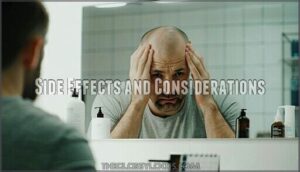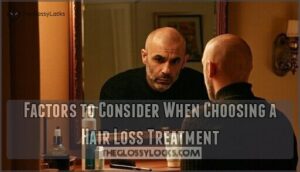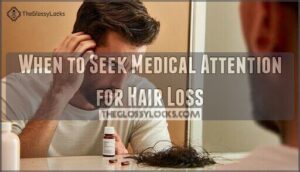This site is supported by our readers. We may earn a commission, at no cost to you, if you purchase through links.
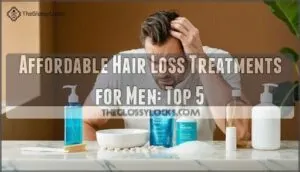
Minoxidil foam and finasteride pills lead the pack—think of them as the trusty tools in your grooming kit.
Brands like Roman and Hims make getting these a breeze, as easy as ordering takeout.
Don’t forget, though: results take time, and some wallets might groan at fancier solutions like laser gadgets or fancy serums.
You might not grow a lion’s mane overnight, but you can slow the shedding.
Curious why some shampoos work for your buddy but not you? The answers might just surprise you up ahead, with trustworthy tools and fancy serums being key considerations, and finding the right treatment can be a breeze.
Table Of Contents
- Key Takeaways
- Top 5 Affordable Hair Loss Treatments for Men
- Understanding Male Hair Loss Causes
- Different Types of Hair Loss in Men
- Comparing Topical and Oral Hair Loss Treatments
- Factors to Consider When Choosing a Hair Loss Treatment
- When to Seek Medical Attention for Hair Loss
- Healthy Lifestyle Changes to Support Hair Growth
- Frequently Asked Questions (FAQs)
- What’s the best hair loss treatment?
- Can hair actually grow back?
- How do you treat a receding hairline?
- How do you treat balding at the top of the head?
- Why am I losing my hair?
- Do I need to see a doctor for hair loss?
- Can I ever stop taking my hair loss treatment?
- Do hair loss treatments cause ED?
- Does insurance cover hair loss treatments?
- What is the most effective treatment for hair loss in men?
- Conclusion
Key Takeaways
- You’re in control of your hair loss, and there are affordable treatment options available, such as minoxidil foam and finasteride pills, that can help slow shedding and promote hair growth.
- It’s essential to understand the causes of hair loss, whether it’s hormonal, genetic, or stress-related, to choose the most effective treatment, and you can consider options like Rogaine, Stem Cell Scalp Serum, or Viviscal Men’s Hair Growth Supplements.
- You’ll need to be patient, as results from hair loss treatments can take time, typically 3-4 months, and it’s crucial to commit to long-term use to maintain the effects, so don’t expect overnight miracles.
- When selecting a hair loss treatment, you should consider factors like the type and severity of your hair loss, budget, and potential side effects, and don’t hesitate to consult a doctor if you’re unsure or experience sudden, rapid hair shedding, as they can provide personalized advice and guidance.
Top 5 Affordable Hair Loss Treatments for Men
You’re looking for affordable hair loss treatments that actually work.
Here are the top 5 options, including Rogaine Men’s Hair Regrowth Foam and other effective solutions, to help you find the best fit for your needs and budget.
1. Rogaine Men’s Hair Regrowth Foam
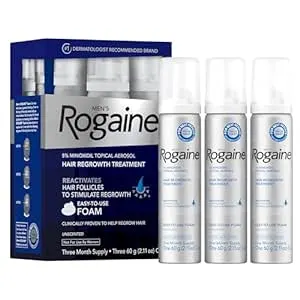
You’re considering Rogaine Men’s Hair Regrowth Foam, a popular choice for thinning hair.
It contains 5% minoxidil, clinically proven to improve hair regrowth, and with Tricho-Prime Technology, it targets early stages of hair thinning.
**Tricho-Prime Technology delivers targeted results where your hair needs it most.
Temporary shedding may occur, but stick with it and you could see regrowth in 3-4 months.
It’s easy to apply, but watch out for the white residue, and Rogaine is a game-changer for thinning spots, and some users even report new growth along their hairline.
Give it a try and see the difference for yourself, with noticeable results in just a few months, making it a potential solution for those experiencing thinning hair.
Best For: men with general thinning of hair at the top of the scalp who are looking for a clinically proven solution to improve hair regrowth.
- Requires consistent use for at least 4 months to see noticeable results, which can be a challenge for some users.
- May cause temporary shedding, which can be alarming for some users, but this typically resolves within 2 weeks.
- Can be expensive, especially if used long-term, and may not be effective for all users, which can be a drawback for some.
- Contains 5% minoxidil, which is clinically proven to improve hair regrowth by 4x in 16 weeks compared to control.
- Features Tricho-Prime Technology to condition the scalp, prevent dryness, and enhance minoxidil absorption.
- Easy to apply and can be used on both wet and dry hair, making it a convenient addition to daily hair care routines.
2. Stem Cell Scalp Serum
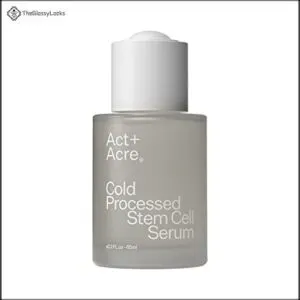
You’re about to discover the power of Stem Cell Scalp Serum. This formula combines Swiss Apple Stem Cells, bamboo, pea extract, and aloe vera to create a potent hair growth treatment.
With 91% of users reporting a nourished scalp and 89% seeing improved hair health, it’s a game-changer. French Oak Extract fights aging signs, while the serum boosts scalp elasticity.
Be mindful of the dropper, but get ready to transform your hair. It’s a simple, effective solution for a healthier scalp and fuller hair, making it an excellent addition to your hair loss treatment routine.
Best For: individuals experiencing hair loss due to hormonal changes, genetic factors, or other causes, who are looking for a natural and effective treatment to promote thicker and fuller-looking hair.
- Combines Swiss Apple Stem Cells, bamboo, pea extract, and aloe vera to create a potent hair growth treatment
- Clinically proven to nourish the scalp and improve hair health, with 91% of users reporting a nourished scalp and 89% seeing improved hair health
- Easy to apply and non-greasy, making it a convenient addition to a daily hair care routine
- The price is a concern for some users, with a relatively high cost compared to other hair loss treatments
- The dropper functionality can be inconsistent, with some users experiencing issues after initial use
- Requires consistent use over several months for noticeable results, which can be a commitment for some users
3. Viviscal Men’s Hair Growth Supplements
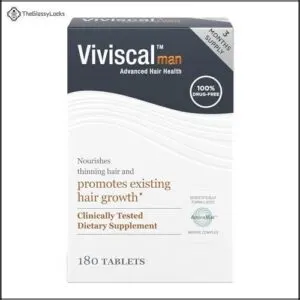
You’re tackling hair loss with Viviscal Men’s Hair Growth Supplements.
These drug-free pills target thinning hair, promising thicker locks in three months.
With 75% of men reporting decreased shedding, you’re on the right track.
Take two pills daily to nourish your hair from within with AminoMar collagen complex, boosting volume and density for a fuller mane.
Best For: men with thinning hair, especially at the first signs of thinning, who are looking for a drug-free supplement to improve hair density and reduce shedding.
- Clinically proven to improve hair density and reduce shedding
- Suitable for all hair types and backed by 25 years of research and development
- Recommended by dermatologists, hair replacement surgeons, and hairstylists
- Pills may be hard to swallow due to shape and texture
- Results may take up to 3 months to become noticeable
- Not a solution for complete hair regrowth in advanced baldness cases
4. iRestore Laser Hair Growth System
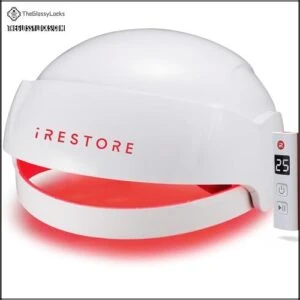
You’re exploring innovative hair growth solutions, and the iRestore Laser Hair Growth System is worth considering.
This FDA-cleared device uses low-level light therapy to stimulate follicles, promoting hair growth. Clinical studies show an average 43.2% increase in hair count.
It’s hands-free, comfortable, and suitable for all hair types. While it’s pricier, the potential results might be worth it, especially with a money-back guarantee.
You’ve got little to lose but your baldness, making it an attractive option for those seeking a non-invasive hair growth solution with promising clinical results. The effectiveness of laser hair therapy is supported by clinical evidence, making it a viable treatment option for many individuals.
Best For: individuals with alopecia, receding hairline, balding, and thinning hair who are looking for a non-invasive hair growth solution with promising clinical results.
- Power cord design prone to kinking, potentially affecting durability
- Initial regrowth may include white hairs due to damaged follicles
- Requires a long-term commitment for sustained results
- FDA-cleared and clinically proven to promote hair growth in men and women
- Hands-free, lightweight, and comfortable design for home use
- Can be used alone or combined with other hair loss treatments for enhanced results
5. HairStem DHT Blocker Shampoo
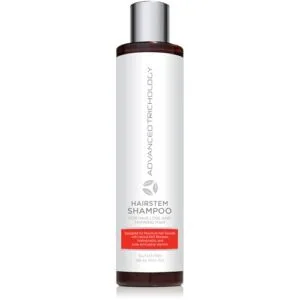
You’re on the hunt for a hair loss solution. HairStem DHT Blocker Shampoo is a game-changer, with biotin, saw palmetto, and tea tree oil blocking DHT hormones that contribute to thinning hair.
It’s sulfate-free, cruelty-free, and clinically developed. Users report thicker, darker hair and reduced scalp itching.
This shampoo is like a shield for your scalp, giving your locks a fighting chance. With its powerful blend, you can feel good about what you’re putting on your head, and it might just be the solution you’ve been searching for to tackle hair loss.
Best For: individuals experiencing hair loss, particularly those with early thinning, as it helps block DHT hormones and supports scalp health.
- Clinically developed and tested to block DHT hormones and support hair growth
- Sulfate-free, cruelty-free, and made in the USA, making it a good option for those with sensitive scalps or preferences for natural products
- Contains a powerful blend of ingredients, including biotin, saw palmetto, and tea tree oil, to nourish and protect the hair and scalp
- Not suitable for use on facial hair, as DHT is essential for beard growth
- May not be effective for complete baldness or dead follicles, and consistent use is necessary to see optimal results
- Requires daily or every-other-day use and may need to be combined with other products for a comprehensive hair loss treatment protocol
Understanding Male Hair Loss Causes
You’re likely experiencing hair loss due to a combination of hormonal and genetic factors.
Understanding the causes of your hair loss will help you choose the most effective treatment, so let’s take a closer look at what’s driving your balding.
Hormonal Influences on Balding
You’re likely experiencing male pattern baldness due to hormonal imbalances, specifically androgenetic alopecia.
DHT, a byproduct of testosterone, affects hair follicles, leading to balding patterns.
Consider DHT blockers or hormone therapy to address this issue, a key factor in hair loss treatment for men.
Understanding the role of hormone therapy can help individuals develop effective strategies to combat hair loss.
Genetic Factors in Alopecia
Your genes largely determine your hair’s destiny, with androgenetic alopecia affecting nearly 95% of balding men.
Your genetic makeup is the number one factor guiding your hair’s future, shaping the patterns of male baldness.
Hereditary baldness follows predictable patterns passed down through family lines, making genetic factors the primary culprit behind male pattern baldness.
- DHT sensitivity inheritance – Your hair follicles’ vulnerability to DHT effects comes from both parents
- Genetic testing availability – Modern tests can predict your alopecia causes and progression timeline
- Family pattern recognition – Look at maternal grandfathers and paternal relatives for clues
- DHT blockers effectiveness – Knowing your genetic predisposition helps choose targeted hair loss treatment options
Different Types of Hair Loss in Men
Not all hair loss follows the same pattern, and recognizing these differences can help you choose the right approach.
Male pattern baldness (androgenetic alopecia) affects about 95% of men experiencing hair loss.
You’ll notice it starting at your temples or crown, creating that classic "M" shape or bald spot.
This baldness type happens when DHT shrinks your hair follicles over time.
Telogen effluvium causes widespread hair shedding after stress, illness, or major life changes.
Your hair literally goes into shock and falls out months later.
Alopecia areata creates coin-sized bald patches when your immune system attacks hair follicles.
It’s unpredictable and can happen anywhere on your scalp.
Traction alopecia results from tight hairstyles pulling on your hairline.
Think man buns, braids, or constantly wearing hats.
Anagen effluvium causes rapid hair thinning, often from medications or treatments.
Each alopecia cause requires different hair loss treatment strategies, so identifying your specific baldness type matters for effective results.
Comparing Topical and Oral Hair Loss Treatments
Choosing between topical and oral hair loss treatments can feel like picking between a lotion and a daily vitamin—both have strengths, and each comes with its own routine.
You’ll want to know how these options stack up regarding results and practical use, so let’s get right to the facts.
Efficacy and Application
Thinning at the crown or widow’s peak? Choosing the right hair loss treatment depends on your goals.
Topical Minoxidil targets Scalp Health right where you apply it, helping with visible Hair Regrowth and hair thickening.
Oral Finasteride works from within, showing broader Treatment Outcomes. Both medications offer proven Hair Regrowth but require patience—results don’t show up overnight.
For effective hair regrowth, consider exploring hair loss treatments to find the best option for your needs.
Side Effects and Considerations
Even with the best hair loss treatment, side effects might rear their heads. Topical solutions can trigger scalp irritation or stray hair sprouting on your forehead. Oral options, like dutasteride, bring risks like sexual dysfunction.
Talk to your doctor about medication risks and treatment duration. Long-term use means weighing balance, tracking hair shedding, and managing your regrowth timeline.
Consider using a hair loss system to minimize risks and maximize results.
- Scalp irritation can pop up unexpectedly.
- Regrowth timeline might test your patience.
- Oral medication risks vary, so check your options.
Factors to Consider When Choosing a Hair Loss Treatment
When you’re choosing a hair loss treatment, it’s important to look at the type of hair loss you have.
How much you’re willing to invest over time is also crucial, as you don’t want to spend a fortune on products that end up living in your bathroom cabinet longer than on your scalp.
Severity and Type of Hair Loss
Struggling with hair shedding or that sneaky patch of thinning hair?
Figuring out if it’s male pattern baldness, stress, or another alopecia cause is key.
Not all baldness types march to the same beat—your treatment should match your diagnosis.
The right hair growth medication or alopecia treatment depends on your pattern, severity, and how your scalp reacts.
Understanding the various hair regrowth options is essential for making informed decisions about your hair loss treatment.
Cost and Long-Term Commitment
Once you know what’s causing your hair loss, it’s time to look at the numbers.
Treatment costs run the gamut—from affordable hair growth products at $11 a month to hair restoration costs soaring past $6,000.
Budgeting for the long term? Ongoing solutions like minoxidil mean daily commitment and accumulated costs, while a hair transplant’s price tag is upfront but hefty.
Most insurance coverage won’t pitch in, so smart financial planning makes certain your cost of treatment doesn’t break the bank.
Understanding effective hair loss treatments is vital for making informed decisions about your hair care regimen.
When to Seek Medical Attention for Hair Loss
Now that you’ve considered treatment options, let’s talk about when to call in the pros. Not all hair loss symptoms are just from getting older or stress.
- Sudden, rapid hair shedding
- Bald spots popping up unexpectedly
- Persistent scalp infections or itchiness
- Hair loss alongside fatigue or weight changes
- No progress after months using hair loss medications
Don’t brush these off—schedule a medical consultation. Emergency care isn’t always needed, but expert hair loss advice never hurts.
Healthy Lifestyle Changes to Support Hair Growth
A few simple healthy lifestyle changes can do wonders for your hair. Start with Nutrition Balance—fuel up with leafy greens, lean meats, and whole grains for the ultimate hair growth diet.
Manage stress like a pro with regular exercise, meditation, or a walk around the block after work. Stress Reduction helps your scalp more than you might think. Prioritize quality sleep, too. Think of sleep as overnight repair for both you and your hair.
Add gentle Scalp Massage to your hair care routine to boost blood flow. Remember, hair loss prevention tips don’t need to be complicated—just consistent, mindful Hair Care works best.
Incorporating a balanced diet plan can substantially improve hair health.
- Leafy greens on every plate
- Yoga mat ready for stress relief
- Gentle scalp massage before bed
Frequently Asked Questions (FAQs)
What’s the best hair loss treatment?
What’s the secret to a full head of hair? You’ll find the best treatment is minoxidil or finasteride, which can help stimulate regrowth and slow down hair loss effectively.
Can hair actually grow back?
You can regrow hair with FDA-approved meds like minoxidil and finasteride, which stimulate follicles and reduce hair loss, showing results in up to a year with consistent use.
How do you treat a receding hairline?
You treat a receding hairline with minoxidil or finasteride, which can help stimulate hair growth and slow down loss, requiring patience and consistent application for noticeable results.
How do you treat balding at the top of the head?
You can combat balding at the top of your head with FDA-approved minoxidil or finasteride, which stimulate hair growth and prevent further loss, showing results in several months.
Why am I losing my hair?
You’re losing hair due to hormonal changes, genetics, or stress, which can affect hair growth and lead to thinning or balding, especially as you age naturally.
Do I need to see a doctor for hair loss?
Just like a car needs a mechanic, you might need a doctor to diagnose hair loss causes, recommending the right treatment to get you back on track, literally.
Can I ever stop taking my hair loss treatment?
You’ll likely need to continue hair loss treatment to maintain results, as stopping can lead to hair loss resuming, so commitment to long-term use is necessary for maximum effects.
Do hair loss treatments cause ED?
You’re concerned about ED; some hair loss treatments, like finasteride, may cause erectile dysfunction, but it’s relatively rare, affecting about 4% of users, so don’t freak out just yet.
Does insurance cover hair loss treatments?
You’ll likely need to check your insurance policy, as coverage for hair loss treatments varies, with some plans covering prescription medications like finasteride, but not always.
What is the most effective treatment for hair loss in men?
You’ll find minoxidil and finasteride are the most effective treatments for hair loss in men, offering noticeable results with consistent use and patience.
Conclusion
Finding the right hair loss treatment is like finding a perfect puzzle piece.
You’re taking control of your hair loss, exploring affordable hair loss treatments for men, and making informed decisions to slow shedding and promote growth.
With options like foams and pills leading the way in affordable hair loss treatments for men.
- https://getroman.pxf.io/6e512K?rvo_aff=1&rvo_brandid=Ro&rvo_prodid=ae6a3839-2780-44ea-a422-96612357b228&rvo_subid=ae6a3839-2780-44ea-a422-96612357b228&rvo_subid2=%2Fhealth%2Fhair-loss-treatments-for-men&subid1=null&subid2=%2Fhealth%2Fhair-loss-treatments-for-men&subid3=null
- https://keeps.q3qw.net/vn5Q0d?rvo_aff=1&rvo_brandid=Keeps&rvo_campaignid=5425&rvo_prodid=3f4a880a-f7ab-43f2-9264-1d247542c171&rvo_subid=3f4a880a-f7ab-43f2-9264-1d247542c171&rvo_subid2=%2Fhealth%2Fhair-loss-treatments-for-men&subid1=null&subid2=%2Fhealth%2Fhair-loss-treatments-for-men&subid3=null
- https://himsinc.pxf.io/21ZA5M?rvo_aff=1&rvo_brandid=Hims&rvo_prodid=b6d1e9e9-1d35-435c-ba75-41e51a157a08&rvo_subid=b6d1e9e9-1d35-435c-ba75-41e51a157a08&rvo_subid2=%2Fhealth%2Fhair-loss-treatments-for-men&subid1=null&subid2=%2Fhealth%2Fhair-loss-treatments-for-men&subid3=null
- https://pmc.ncbi.nlm.nih.gov/articles/PMC10075351/
- https://www.instagram.com/nataliekashmd/?hl=en


